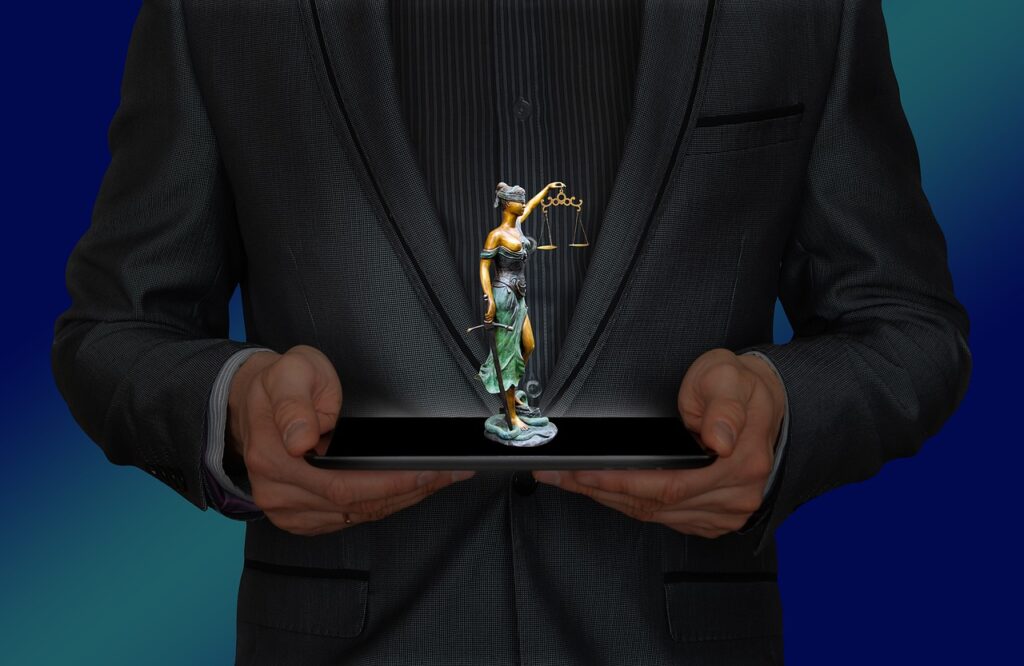Published On: Novemeber 9th 2025
Authored By: Vianca Venkatesh
Symbiosis Law School, Hyderabad
ABSTRACT
This article aims to discuss the contribution of Ronald Dworkin to the development of jurisprudence and the philosophy of law in the contemporary world. His philosophies mainly included the law of integrity and rights as trumps. The most sought-after work of Dworkin was a critique of the applied philosophy of legal positivism by H.L.A. Hart. The key point emphasized was that law is interpretative in nature and that law is moral in nature. Based on the theory advanced by Dworkin, the judicial officers must incorporate morality in judicial decisions so as to achieve integrity in their judgment process. In this part, we will consider the criticism of Dworkin of the Hart-Dworkin argument, his interpretation of rights as individual trumps over groups. We will also look at his thought provocation hypothesis of right answers in hard cases. To compare the influence on the Indian law, in order to have a more real advent of knowledge, we will discuss how the theories of Dworkin impacted the Indian law. Examples as Kesavananda Bharati vs the State of Kerala and Maneka Gandhi vs the Union of India, where the jurisdiction of the Indian courts provides Dworkinian doctrines, will be examined. Therefore, Dworkin’s theoretical approach will continue to make a significant contribution to the constitutional and judicial way of thinking and the development of legal justification, thus providing an alternative way to both legal positivism and legal realism theories.
INTRODUCTION
Ronald Myles Dworkin is one of the most radical lawyers of both the 20th century and the beginning of the 21st century, who really transformed the current positions of rights and law and the explanation of the judgments. Dworkin, as a professor at Yale, New York and Oxford universities, challenged the orthodoxies of legal positivism and introduced an alternative theory that succeeded in uniting law and morality.
The intellectual pilgrimage of Dworkin had its origins in the 1960s, at a time during which positivism and especially its version advocated by H.L.A. Hart reigned in the field of jurisprudence. The traditional understanding of law and morality places these dimensions in different conceptual worlds, the validity of which depends not on values but on social facts. Amid that, Dworkin emerged as a pungent critic of such theories, arguing that law requires an aspect of interpretation and moral principles are significant in legal reasoning.
We shall attempt to explore how far Dworkin rejects the positivist position and what contribution he made to the contemporary legal theory through his two concepts of Law as Integrity and Rights as Trumps and how far it has shaped the Indian constitutional jurisprudence as encapsulated in some of the most significant judgments. We shall give a chronological exposition of Dworkin’s intellectual progression, including his biographical background, major theoretical inventions and ultimate success in the West and India in American jurisprudence.
THE IDEAS OF DWORKIN
Law As Integrity
Dworkin has written in his theory of law his most complete rebuttal to legal positivism. According to this theory, law is to be interpreted as a method of an interpretive practice as opposed to the legal materials. This integrity with regard to the government in the terms of Dworkin will demand that the government speaks with one voice and acts on a unified set of principles that permit the government to treat all the citizens with equal consideration and respect.
This would run on a two-tiered mechanism, which is legislative integrity and judicial integrity. Legislative integrity would compel the legislators to make laws in a manner that they appear to be morally as well as politically right. Judicial integrity would involve the judges interpreting the existing legal material with a comprehensive vision of fairness and justice.
To exemplify this procedure, Dworkin has employed the example of his notorious judge, Hercules. Hercules has inhuman powers of intellectual skills and unlimited time. In application, once Hercules confronts a tough case, he formulates a scrupulous theory that is capable of accommodating both the relevant legal texts as well as the best moral illumination. In his experience, this would involve two steps, the first step which would involve knowing the interpretations that will suit the institutional history of the case. Second, there is the process of choosing the interpretation that should render the law more suitable to the case in terms of the political morality surrounding it.
Rights as Trumps
The critical contribution made by Dworkin was his view that the rights override the collective interest. This implies that the rights of an individual take a special precedence over otherwise claims based on collective good and social welfare. In his opinion, the purpose of rights is to act as protective fencing areas for their subjects, so they would not be sacrificed in an attempt to achieve social utility. This is explainable with an example. Freedom of speech cannot be abolished or deprived on the argument that this can help decrease social tensions and have a positive impact on the economy. Rights are restrictions on the utilitarian calculations. This is achieved by making sure that persons are not viewed as means towards collective ends, but they are seen as ends.
By examination, Dwokrin has differentiated the right claims into categories. Abstract rights are undifferentiated political goals which are proclaimed without any reflection to the weight and their potential impact on other political goals. Political aims are decidedly the opposite of concrete aims, since they explicitly weigh against other factors. Institutional rights are those rights that give us a justification for the decision that a certain political institution has made. Background rights are basic and fundamental moral rights that predate and transcend any given arrangement. Background rights, in turn, in the theory of Dworkin, mediate between moral principles and institutional practice.
The Judge’s Role
The significant effect of Dworkin’s theory is that it redefines the role of a judge. The main principle of his theory is to oppose both the mechanical rule application and unlimited judicial discretion. Rather, as proposed, judges should indulge in constructive interpretation. This would be a process that would involve integrating aspects of finding and creating. Judges are supposed to uncover the premises that best interpret the legal texts and they must actively engage themselves in the creation of the moral commitments in the legal system. Such an exercise would place the judges in the position of having to guard against two counter pulls of fitness and justification. The fit dimension ensures that interpretations should be faithful to the current law in place in terms of statutes, precedents and constitutional provisions. The aspect of justification requires that there should be interpretations of the materials in the best moral and political light thereof.
Dworkin refers to a chain novel as a metaphor to explain this process. Every one of the judges is viewed as a novelist who writes one of the chapters of a single story. He is boxed in by what has already happened, as well as is charged with creating the story as good as he can going forward. In a way, the chapters that precede influence the subsequent chapters in this manner, so that the preceding chapters limit the subsequent chapters and the latter redefine the meaning of the former.
This point specifically is highly contrary to that of the legal positivism theory in terms of judges. Where the positivists watch the judges use discretion as the rule of the law comes to an end, Dworkin sees the judges on the same line, only they remain bound by the law. This is specifically done through principles which give the most satisfactory explanation to the law in a broad term.
LEGAL POSITIVISM CRITIQUE
The critique that Dworkin continued to modify of legal positivism, was eventually his major output, but this as well evolved throughout several decades. This crux can be elucidated in three key aspects that challenge three key positivist theses
Dworkin propounded the model of rules vs principles, that legal systems had rules and principles. This was the opposite of the positivist assertion that the law is composed of rules alone. Principles have a weight associated with them, which enables them to be contested by other principles without being falsified. Tules, however, are a very particular matter on how they apply or fail to apply to them.
The claim of the positivists through the pedigree test is that validity based on the positive law lies completely in the social pedigree of a norm. The point of the argument presented by Dworkin is that numerous principles of law do not require a clear social derivation or background, but still their role in arguments before the law is prominent.
Moreover, the positivist argument that the judges ought to use their high discretion in the hard cases in itself explains that they are the creators of law rather than the administrators of the existing law. Dworkin claimed that this was a deplorable oversimplification of the judges’ power. Judges ought to be interested in finding the law as opposed to making law.
In these criticisms, a very significant debate in jurisprudence was born these days, known as the Hart-Dworkin debate. Hart and his school reacted to this by developing more nuanced types of legal positivism, i.e., the exclusive and the inclusive versions. Strictly positivist opinions, including that of Joseph Raz, hold that moral criteria are never sufficient conditions of a legal validity. Moral concepts, particularly, were argued by inclusivist positivists like Jules Coleman to be relevant to validity, by virtue of being part of rule-of-recognition of a legal system.
IMPACT ON THE INDIAN JURISPRUDENCE
The potential practical implications of such a theoretical construct can be captured by analyzing some of the Supreme Court of India cases.
In the case of Kesavananda Bharati vs State of Kerala (1973), the notion of the basic structure was created that some fundamental elements of the constitution cannot be altered. This carried the motifs of Dworkin regarding constitutional integrity and fundamental rights. In shielding the central structure of the Constitution against majority override, the court invoked the rights as a trump card.
In Maneka Gandhi vs. Union of India (1978), it was landmarkly observed by the court that fundamental rights were to be interpreted in a liberal manner and in a non-conflicting way. The Court did not subscribe to that sort of narrow textual interpretation of the Constitution. A more principle-based approach was preferred in the court. The opinion of Justice Bhagwati in particular focused on the notion that provisions in the constitution must be interpreted to grant as many safeguards as possible on individual rights.
This is not unlike the methodology of Dworkin in interpretation. Instead of being interpreted as stand-alone provisions, constitutional provisions were considered as links in a chain, which constituted a structure meant to lead to the protection of human dignity and freedom of the individual.
The further existence of the tendency toward Dworkinian explanation was evident in the case of Shayara Bano vs Union of India (2017). The ruling of the court, which stated the practice of triple talaq as null and void, was based on equal treatment of people irrespective of gender, and this was above religion. According to the opinion of Justice Rohinton Nariman, it was argued that religious practices could not trump the constitutional provisions that would go against fundamental rights.
LIMITATIONS
The chief arguments against the Dworkinian interpretative theory were that it could offer little guidance in relation to judicial decision-making. The question was whether reasonable judges properly could draw otherwise decisive conclusions on the obligation of the law. This, in fact, neutralizes the assertion by Dworkin about the existence of right answers to legal questions. The theory is not able to limit the judicial decision-making by Dworkin. The absence of a consistent criterion for selecting among various interpretations can lead to the problem of political self-interest shown by the judges.
Largely, the critique questioned the theory entertained by Dworkin that there is a moral truth that should be unearthed by the courts. To the extent that moral disagreement is ubiquitous, the interpretative theory advanced by Dworkin can camouflage political choice as legal reasoning. Philosophers state that moral properties do not form part of the reality structure. When tested against this, Dworkin can make a philosophical mistake in his theory.
In addition, other non-Western philosophical critics say that Dworkin pays too much attention to liberal values among Westerners. Such a focus on individual rights and human dignity might not be universal in application to the various contexts.
CONCLUSION
The legacy of Ronald Dworkin is, arguably, a revolution in intellectual modern jurisprudence. It has changed, radically, the relationship between law and morality and judicial decision. He has developed a highly graceful reconciliation of the old legal dogmatism, which consisted in opposing legal formalists to judicial activists. The law as integrity by Dworkin reinvents judges as applicators rather than as interpreters who secure that decisions of the law are not only fitting to precedent but also explainable as consistent with the principles of equal concern. The same was explained through his chain novel metaphor. An empowerment of courts to safeguard individual dignity has been achieved through his rights as a trumps doctrine.
It is difficult to disagree with Dworkin that law and morality are joined by the same string, especially when democracies face the problem of conflict between rights and wealth inequality. His ethical crusade in the name of a mature interpretation of the law and a harried preservation of rights assures the inerasability of his imprint on constitutional contest over justice. His contribution to the field of jurisprudence cannot be undermined and it has made us question the existence of a relation between law and morality. Even though the answer to the oldest question of whether them being related or not is not perfectly answered, we established a better understanding of the relationship, and that understanding will only increase in the future.
BIBLIOGRAPHY
-
- Ronald Dworkin, Taking Rights Seriously (Harvard University Press 1977)
- Ronald Dworkin, A Matter of Principle (Harvard University Press 1985)
- Ronald Dworkin, Law’s Empire (Harvard University Press 1986)
- Ronald Dworkin, Life’s Dominion: Abortion, Euthanasia and Individual Freedom (Knopf 1993)
- Ronald Dworkin, Freedom’s Law: The Moral Reading of the American Constitution (Harvard University Press 1996)
- Kesavananda Bharati v State of Kerala (1973) 4 SCC 225 (SC)
- Maneka Gandhi v Union of India (1978) 1 SCC 248 (SC)
- Shayara Bano v Union of India (2017) 9 SCC 1 (SC)
- John Austin, The Province of Jurisprudence Determined (Cambridge University Press 1832/1995)
- John Austin, The Province of Jurisprudence Determined (Cambridge University Press 1832/1995)




